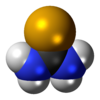Selenourea
|
|
|||
| Identifiers | |||
|---|---|---|---|
|
630-10-4 |
|||
| 3D model (Jmol) | Interactive image | ||
| ChEBI |
CHEBI:36957 |
||
| ChemSpider |
10293781 |
||
| ECHA InfoCard | 100.010.119 | ||
| EC Number | 211-129-9 | ||
| MeSH | C081959 | ||
|
|||
|
|||
| Properties | |||
| CH4N2Se | |||
| Molar mass | 123.02 g/mol | ||
| Appearance | Pink/grey solid | ||
| Melting point | 214 °C (417 °F; 487 K) | ||
| Boiling point | 200 °C (392 °F; 473 K) | ||
|
Except where otherwise noted, data are given for materials in their standard state (at 25 °C [77 °F], 100 kPa).
|
|||
|
|
|||
| Infobox references | |||
Selenourea is the organoselenium compound with the formula SeC(NH2)2. It is a white solid. This compound features a rare example of a stable, unhindered carbon-selenium double bond. The compound is used in the synthesis of selenium heterocycles. Compared to urea, the oxo-analog of selenourea, few studies have been done on the compound due to the instability and toxicity of selenium compounds.
The compound was first synthesized in 1884 by Auguste Verneuil by the reaction of hydrogen selenide and cyanamide:
While this reaction has even found use in industrial synthesis of selenourea, more modern methods concern themselves with synthesis of substituted selenoureas. These can be synthesized using organic isoselenocyanates and secondary amines:
Alternatively, a substituted carbodiimide could be used as follows:
X-ray crystallographic measurements on crystals at -100 °C give average C=Se bond lengths of 1.86 Å, and 1.37 Å for C-N. Both the Se-C-N and N-C-N angles were measured at 120°, as expected for an sp2 hybridized carbon. Through these same studies, the existence of Se-H hydrogen bonding in the crystal lattice—suggested from to the O-H and S-H hydrogen bonding found in crystals of oxo- and thiourea—was confirmed.
Both the shortened length of the N-C bond and the longer Se=C bond suggest a delocalization of the lone pair on the amines; the Se=C π-bonding electrons are drawn towards the Se atom, while the N-lone pair is drawn towards the carbonyl carbon. A similar effect is observed in oxo- and thiourea analogs. In going from urea to thiourea to selenourea the double bond is more delocalized and longer, while the C-N σ bond is stronger and shorter. In terms of resonance structures, the selenol form (structures II, III) is more prevalent compared to oxo- and thione analogs; however, the lone pair the nitrogen of selenourea delocalizes only slightly more than the lone pair on thiourea (in contrast to a much greater delocalization in going from urea to thiourea). These minor differences suggest that the properties emergent from the delocalized N-lone pair and destabilization C=S and C=Se π bond in thiourea and selenourea will also be similar.
...
Wikipedia


